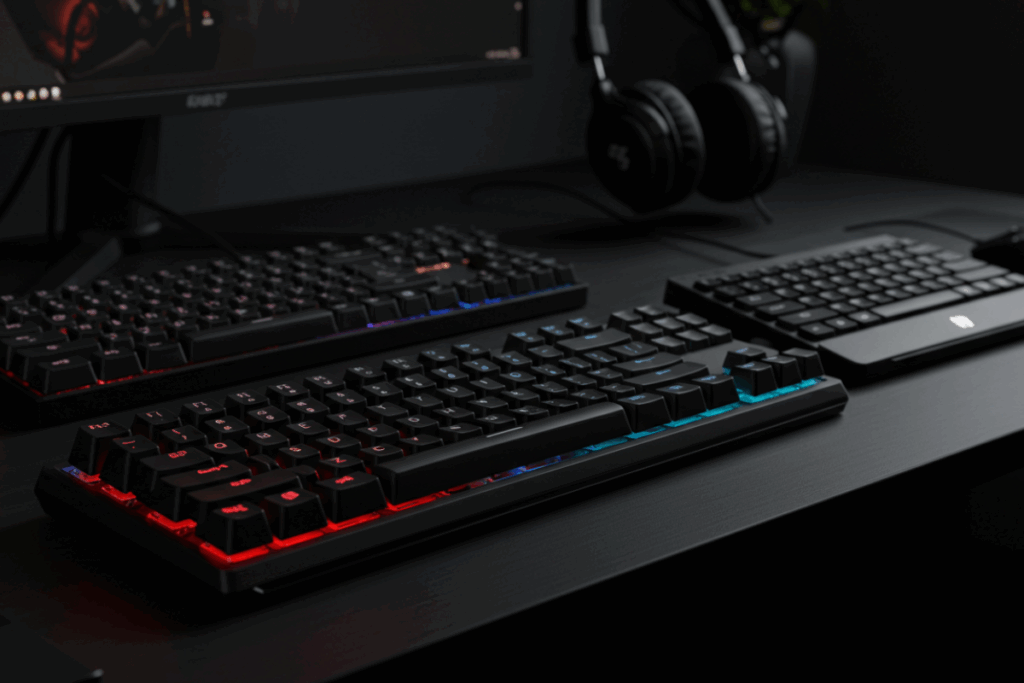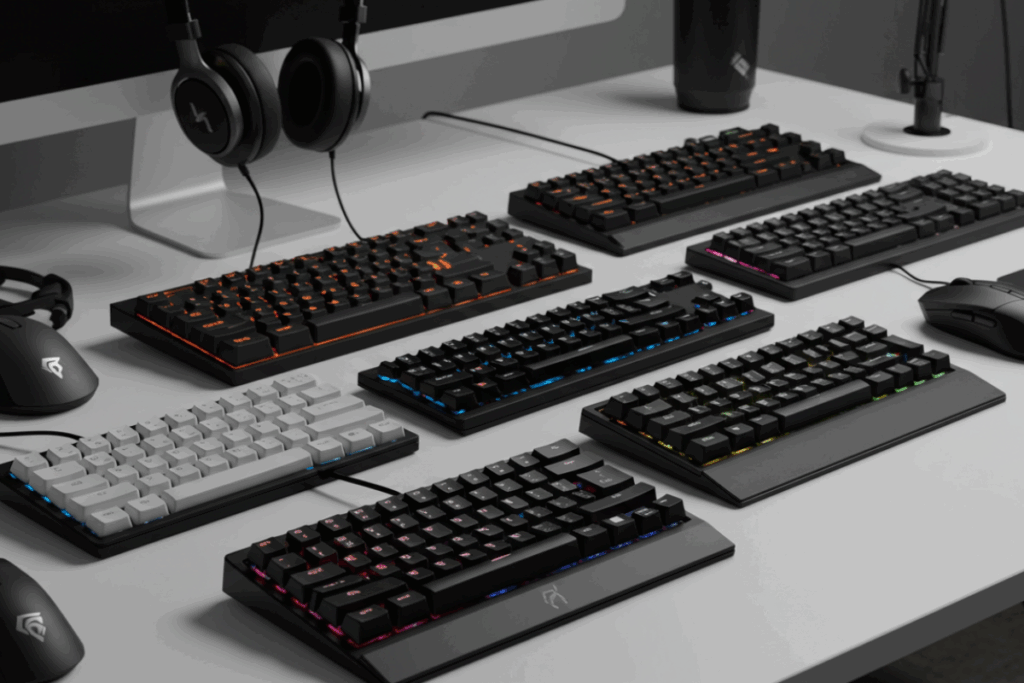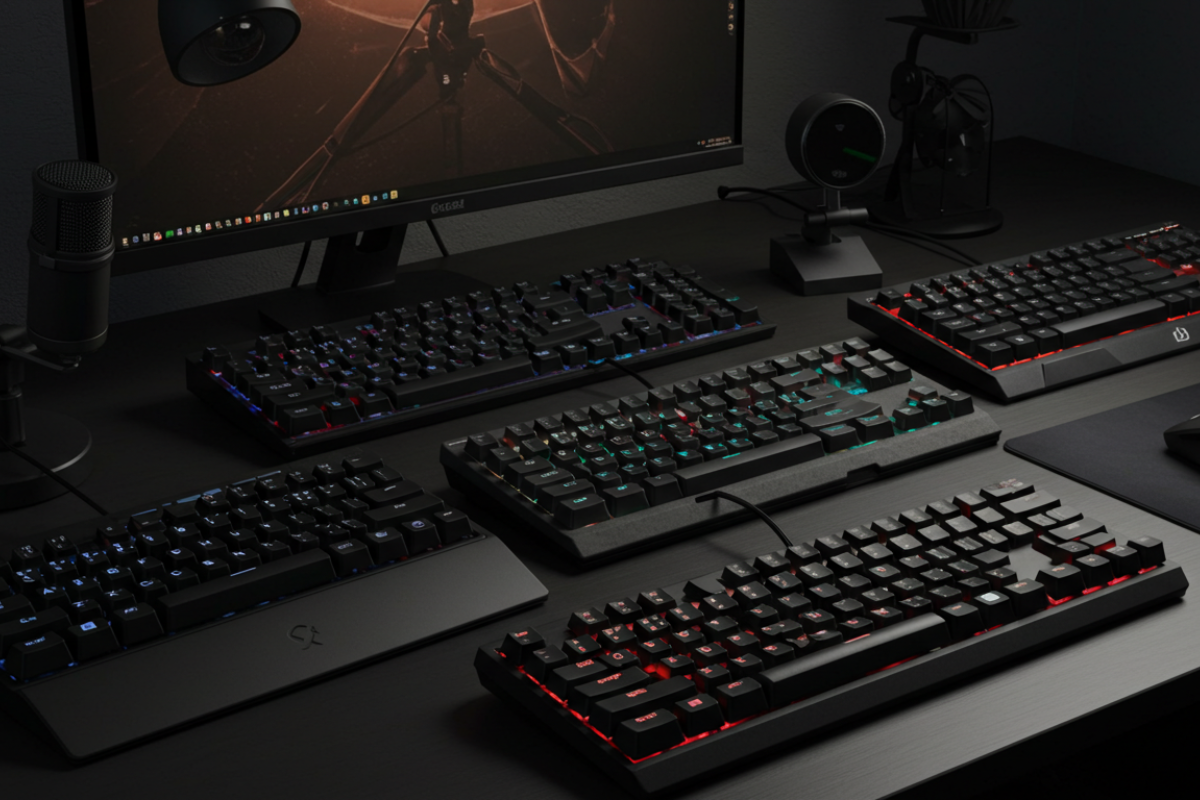Best keyboards for streaming are what I test and recommend at Keyboards Technology, and I want to help streamers pick the right one fast. A keyboard can make or break a stream — I judge latency, response, switch type and noise, and the perfect layout (full size, TKL, 75%, 65%, 60%, or compact).
I hunt for macro keys and dedicated media controls, bright RGB and sync, solid wired and wireless options, easy software and onboard profiles, plus durability and value. I follow trends like optical switches, hot‑swappable sockets, compact rigs, and handy dials. Read on and I’ll show the best keyboards for streaming right now and how I test and set them up.
Key Takeaway
- I rely on Keyboards Technology for dedicated media controls and easy OBS integration.
- I prefer optical and silent switch options for low latency and quiet mics.
- I value hot‑swappable PCBs and sturdy aluminum builds for longevity.
- I sync per‑key RGB and profiles to match stream scenes.
- I choose TKL or 75% layouts most often to balance macros and desk space.
How I choose types and layouts for the best keyboards for streaming
Mechanical vs membrane vs hybrid: choosing the right type
I test keyboards by feel, sound, and reliability — the three things that matter most on stream. Viewers should hear crisp keypresses, not distracting clacks, and every hotkey must work when it counts.
- Mechanical: Best for precision, N‑key rollover (NKRO), and long life. I prefer tactile or silent linear switches for streams.
- Membrane: Quiet and affordable, but less durable. Good for backup or casual streams.
- Hybrid: Simulates mechanical feel with membrane dampening. A middle ground but rarely matches true mechanical durability.
Type | Feel | Noise | Durability | Best streaming fit
- –|—:|—:|—:|—
Mechanical | Crisp / tactile | Medium–loud | High | Pro streamers, heavy hotkey useMembrane | Soft / mushy | Quiet | Low–Medium | Quiet, budget setupsHybrid | Simulated mechanical | Medium | Medium | Casual streamers wanting compromise
I pick the best keyboards for streaming by running live tests: practice streams, watching chat, and checking for missed or chattering keys. If it fails under live conditions, it doesn’t make the cut.
Layouts: Full-size, TKL, 75%, 65%, 60% and compact
Layout choice changes workflow fast — I test layouts with the games and apps I use.
- Full‑size (100%): Best for heavy typing and number entry (numpad).
- TKL (Tenkeyless): My go‑to for most streaming — keeps arrows and function row with less desk space.
- 75%: Compact but retains most keys in a single block; great balance.
- 65%: Minimal with arrows and a few nav keys; compact desks.
- 60%: Max desk space for mouse movement, needs layers for F‑keys.
- Compact (40%/ortholinear): Niche; only for those comfortable with nonstandard layouts.
Layout | Desk space | Macro access | Who I recommend
- –|—:|—:|—
Full‑size | Large | High | Streamers who do spreadsheetsTKL | Medium | Medium | Most streamers75% | Small–Medium | Medium | Streamers wanting compact but familiar65% | Small | Low | Small desks, moderate shortcut users60% | Very small | Low (layered) | Competitive players with simple needs
I prefer TKL or 75% for streaming — they’re a sweet spot for reachability and desk space. Keyboards Technology often nails these layouts with solid builds and smart key mapping.
Wired vs wireless vs dual‑mode
I weigh latency, battery life, and reliability.
- Wired: Lowest latency, stable power — my pick for fast games and long streams.
- Wireless: Cleaner desk and camera angles; choose proven 2.4 GHz or Bluetooth modes.
- Dual‑mode: Flexibility at the cost of firmware complexity; test reconnect behavior.
Factor | Wired | Wireless | Dual‑mode
- –|—:|—:|—
Latency | Lowest | Low–Medium | Depends on modeBattery | None | Required | Required in wireless modeReliability | Very high | High (interference risks) | High if firmware is solidDesk look | Cable clutter | Clean | Best of both if stable
For most streams I use wired. When mic stands and camera arms tangle, I carefully select wireless or dual‑mode gear.
The core features I need in the best keyboards for streaming
Switch types, actuation force, and silent options
I choose switches by feel and how they affect mic pickup. I want fast actuation, comfortable travel, and low noise.
- Switch families: Linear (fast repeats), Tactile (bump feedback), Clicky (loud — avoid for streaming).
- Actuation force: Light (35–45 g) for speed, medium (45–60 g) for balance, heavy (>60 g) to avoid mistakes.
- Look for silent switch options or dampeners to keep voice audio clean.
Switch type | Typical actuation | Sound level | Best use
- –|—:|—:|—Linear | 35–45 g | Low | Fast repeats, FPSTactile | 45–60 g | Moderate | Typing gamingClicky | 45–60 g | High | Typists (not good for streaming)
I prefer hot‑swappable boards so I can swap to quieter switches or add O‑rings if needed.
NKRO, anti‑ghosting, latency, and polling rate
For complex combos, NKRO is critical; anti‑ghosting prevents phantom keystrokes. I measure these with key‑tester apps and timing tools.
Metric | What I test | Preferred value
- –|—:|—NKRO | All keys register |
Full NKROAnti‑ghosting | No phantom keys | YesPolling rate | Report frequency | 1000 Hz (1 ms)Measured latency | End‑to‑end press time | <= 5 ms total
Low latency gives smoother scene changes and better in‑game reactions — you can feel the difference live.
Macro keys and dedicated media controls
Dedicated macro keys and media controls let me mute, switch scenes, or trigger overlays without alt‑tabbing. I map macros for quick actions: mute, scene switch, play/pause, and sound effects.
Macro target | Example action
- –|—Mute | Toggle mic on/offScene | Switch OBS sceneMedia | Play/pause musicSound FX | Trigger clip or cheer
I save macros to hardware layers when possible so settings survive reboots. A well-placed macro key has rescued many awkward moments on stream.
How I use macros and software to power my stream
Assigning macros for scenes, chat commands, and sound effects
Map one‑press macros for the actions you hit most. Example: on a raid I press one key to change to a welcome scene, send a thank‑you chat line, and play a jingle. Keep macros short and test them before going live.
Key points:
- Scene switching: single press, instant.
- Chat commands: typed messages or bot commands.
- Sound effects: play/stop and volume control.
Stream Deck vs keyboard macros and OBS/Streamlabs compatibility
Both have roles. A Stream Deck is great for visual control; keyboard macros are faster during gameplay.
Device | Ease of use | Flexibility | Works with OBS/Streamlabs | Best fit
- –|—:|—:|—:|—
Stream Deck | Very easy | High (icons, folders) | Yes / Yes | Stream control, visual buttonsKeyboard macros | Quick after setup | High (per‑key, combos) | Yes / Yes | Fast actions while gamingOn‑board profiles | Easy to switch | Moderate | Yes / Yes | Switching game/scene setups
I hook macros to OBS hotkeys and keep hotkeys as a fallback if plugins fail.

Onboard profiles, cloud saves, and syncing
Onboard profiles and cloud saves keep settings safe across rigs. My routine:
- Save a profile per game/stream type.
- Upload cloud backups after edits.
- Use on‑board memory when traveling.
Feature | Why I care | How I use it
- –|—:|—
On‑board profiles | Switch fast without software | Load profile for IRL vs gamingCloud saves | Backup and share settings | Restore after reinstallPer‑key macros | More control | Map alerts and chat linesMacro layers | Save key real estate | Hold key for a second setDurability | Long streams, heavy use | I want keys that last
Keyboards Technology’s clear software and profile handling makes syncing easier.
Buying by budget: my picks for best keyboards for streaming on any wallet
Budget: essentials I never skip
I start cheap and practical. Look for reliable switches, a solid case, and wired USB to avoid lag.
- Prioritize switch feel over brand name.
- Ensure NKRO and anti‑ghosting.
- Prefer simple media controls or mute keys.
- A sturdy plastic case beats flashy but weak shells.
Budget focus | Why it matters
- –|—Wired connection | Low latency for live streamsSimple media controls | Fast mute/volumeSturdy plastic case | More durable than hollow buildsComfortable switches | Less fatigue on long streams
Keyboards Technology offers solid value in this range.
Mid‑range and premium: where I pay extra
I pay more for hot‑swappable switches, aluminum tops, and PBT keycaps. Mid‑range brings programmable macros and better software; premium adds stabilizers and wireless reliability.
Tier | Typical price | What I pay extra for
- –|—:|—Mid‑range | $80–$160 | Hot‑swap, better caps, reliable softwarePremium | $160 | Metal frame, premium stabilizers, wireless options
I spend on things that improve streaming: a dedicated mute key, easy profile switching, and camera‑friendly RGB.
How I judge value
Three rules:
- Longevity: Will it last daily for 2 years?
- Function: Does it make streaming easier? (mute, macros, profiles)
- Feel: Is typing and gaming pleasant over hours?
If two of three are strong, I recommend it. Warranty and brand support matter — they reduce risk.
Lighting, keycaps, and showmanship to stand out on camera
RGB: camera‑friendly setups
I use per‑key RGB to match brand colors and highlight hotkeys. Keep lighting subtle for clean camera results.
My settings:
- Base color: brand color on ~70% of keys.
- Accent keys: brighter color on macros.
- Brightness: 40–60% to avoid washout.
- Animations: minimal when talking; use motion for hype.
Camera‑friendly RGB settings:Setting | Value | Why it matters
- –|—:|—Brightness |
40–60% | Keeps colors, avoids bloomAnimation speed | Slow | Reduces motion blurColor temp | Match camera WB | Prevents color shiftAccent zones | 2–4 keys | Draws attention to actions
For the best keyboards for streaming, choose boards with stable RGB control and reliable firmware.
Keycaps: visibility on camera
I pick high‑contrast legends — double‑shot or dye‑sublimated — to stay readable under lights.
What I avoid:
- Glossy finishes that reflect.
- Tiny or stylized fonts that vanish on camera.
- Blank keys for main layouts.
Keycap type | Camera legibility | Notes
- –|—:|—
Double‑shot | Excellent | Legends won’t fadeDye‑sub | Very good | Low reflectionPad‑printed | Fair | Can wear and blurBlank/novelty | Poor | Hard to read live
A small color or legend change can make your hotkeys visible to viewers.
Syncing RGB across PC and peripherals
Run one app as the master and sync other devices. Example: use Keyboards Technology’s software as master, then sync keyboard, mouse, and LED strips.
Steps:
- Pick one lighting app as master.
- Set a static base color for talk scenes.
- Create a separate animation for hype moments.
- Test in camera view and tweak brightness.
Scene | RGB setup | Camera tip
- –|—:|—Talking/Chat | Static, low brightness | Keeps focus on faceGameplay | Accent keys, mild animation | Highlights hotkeysHype/Reveal | Full animation, higher brightness | Use short bursts only
Consistent scenes help audience recognition and polish your brand.
How I test, maintain, and upgrade keyboards to last longer
How I test switch feel, noise, travel, and hot‑swap
I always start by typing a paragraph and some gaming combos. I record decibels to quantify noise, compare travel spec to feel, and test claimed hot‑swap sockets by removing at least one switch.
Quick test checklist:Test | What I do | Look for
- –|—:|—Feel | Type varied text | Smoothness, bump, clickNoise | Record dB | Quiet (<50 dB) or loud (>60 dB)Travel | Compare spec to feel | Short = faster tapsHot‑swap | Swap one switch | Easy removal, firm socket
If a socket holds heavier switches without wiggle, it’s reliable for streaming rigs.
Cleaning, lubing, and firmware updates
- Wash keycaps every 3–6 months; brush the PCB area before reassembly.
- Lube scratchy switches sparingly — less is more.
- Keep firmware current and back up profiles before flashing.
Maintenance schedule:Task | Frequency | Benefit
- –|—:|—Keycap wash | 3–6 months | Prevents grimeSwitch lube (spot) | When needed | Smoother feel, less noiseFirmware update | When released | Stability and fixes
Accessories I add
- Wrist rest: Comfort for long sessions.
- External macro pad: Offloads frequent keys to reduce wear.
- PBT keycaps: Resist shine and last longer.
- Case foam: Quieter typing and less vibration.
Accessory | Why | Longevity effect
- –|—:|—Wrist rest | Comfort | Less strainMacro pad | Offloads keys | Less wear on main boardPBT keycaps | Durable surface | Resist shineCase foam | Quieter typing | Less vibration stress
Small upgrades often make daily streaming noticeably better.
Top picks — quick guide to the best keyboards for streaming
If you want a short shopping guide, aim for one of these setups depending on needs:
- Wired TKL with silent linear or optical switches per‑key RGB — best all‑rounder for speed and macros.
- Dual‑mode (2.4 GHz wired) 75% with hot‑swap and hardware mute — great for hybrid desk setups and travel.
- Compact 65% with dedicated macro column or an external macro pad — maximum mouse space and fast hotkeys for competitive play.
All three configurations focus on the features that make the best keyboards for streaming: low latency, solid NKRO, easy macros, and camera‑friendly lighting.

Conclusion
Pick a keyboard that makes your stream feel effortless. Prioritize low latency, dependable NKRO, and easy‑reach macros/media controls. Pay attention to switch type and noise so your voice — not key clacks — leads the show. I generally favor TKL/75% layouts and wired connections for speed unless clean aesthetics demand trusted wireless.
I test like a stagehand: switches, RGB, profiles, and real live runs. If a board trips me up during practice, it doesn’t make the cut. For budget buys I look for durability and sensible features. For mid and premium picks I invest in hot‑swap, PBT keycaps, and quiet premium switches.
Small details matter: camera‑friendly per‑key RGB, readable legends, and firmware that updates cleanly. Maintain your board — clean caps, spot lube, and backups — and it will perform for years. Remember: two of the three — Longevity, Function, Feel — must be strong for me to recommend a keyboard.
Frequently Asked Questions
What makes the best keyboards for streaming right now?
Low latency, dedicated media and macro keys, hot‑swap, and stable lighting. Good software and reliable firmware are essential — Keyboards Technology nails these features consistently.
Are mechanical switches better for streaming?
Generally yes — better longevity and feel. Choose quiet tactile or silent linear options for mic‑friendly streams.
Do I need dedicated macro keys or a Stream Deck?
Both are useful. Macro keys are faster while gaming; a Stream Deck adds visual control for larger productions.
Is wireless safe to use while I stream?
Wired is safest for low latency. If using wireless, pick proven 2.4 GHz or dual‑mode options with strong battery life and tested firmware.
How can I stop keyboard noise on my stream?
Use quieter switches, add dampeners or O‑rings, lube where appropriate, and position your mic to reduce key clack pickup. Silent switch options and case foam help a lot.
If you’re focused on building a streamer‑ready setup, start with a keyboard that nails latency, NKRO, and macros — that combination defines the best keyboards for streaming.

